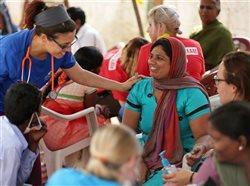
Cultural awareness, collaborative spirit: Building a culture of health
(BPT) – Patient behavior and attitudes about health are deeply rooted in outside influences like cultural and societal norms. Thanks to their role in providing person-centered care, a type of care that takes a patient’s physical and emotional well-being into account, nurses develop close relationships with their patients. That’s why nurses’ understanding of a community’s traditions and culture as well as patient habits is essential to identifying potential health risks and barriers and proactively managing them with patients firsthand.
This community-driven mindset and evaluation of each patient’s needs within the broader context of their life supports what the Robert Wood Johnson Foundation (RWJF) calls a ‘culture of health.’ A culture of health exists when every citizen is empowered to live the healthiest life they can in and out of the health care setting. It is fueled by the families, health care teams, and other communities of care that contribute to overall health of patients.
Patient and community-first mindset
To build a healthier society, nurses must understand variables affecting each patient’s health – many of which stem from their family and home environment. Patients are part of a larger ecosystem, and incorporating their worldviews and backgrounds when developing effective treatments is not an aspirational goal, but an integral part of a nurse’s job.
‘For nurses, building a culture of health means many things, including having a deep understanding of each patient’s concerns, and arming them and their caregivers with tools and education to manage them,’ says Roberta Raymond, assistant professor in the Master of Science in Nursing (MSN) degree program at Chamberlain College of Nursing.
This person-centered mindset is especially important in today’s global society, where nurses interact with a diverse group of patients with different attitudes, beliefs, habits, education, financial stability and family backgrounds.
Healthier societies through professional collaboration
Cultural congruency is a team effort that involves partnerships between patients and health care professionals. By enabling interprofessional, collaborative communication between health care providers and enhancing the continuity of care from hospital to home, nurses may be better equipped to understand and react to community health indicators and needs.
One nurse who is building a healthier society through professional collaboration is Linda Minnich, a staff nurse at John Muir Health in Los Angeles, who is leading the cross-professional charge in her region. A recent Chamberlain graduate of the Bachelor of Science in Nursing (BSN) program, Minnich passionately co-chairs her hospital’s Quality Pain Management Team.
The Quality Pain Management Team assembled in 2012 to identify best practices addressing post-surgical or chronic pain management. Minnich and her colleagues developed new treatments for patients with a variety of pain management issues ranging from nerve pain after joint replacement and hip fractures to post-surgical chronic pain. The successful program was picked up by the Veterans Health Administration (VHA), a national health care alliance, as a framework to help other facilities achieve the same success.
‘I saw an opportunity for nurses to work more closely with anesthesiologists to understand the latest treatments available,’ Minnich says. ‘We noticed many patients were experiencing the same symptoms, so collaborating with other departments showed us new pain management techniques that will be our standard level of care moving forward.’
From the classroom to the community
Minnich’s interprofessional success was shaped by learning from community-minded nursing professors who led by example in supportive classroom settings.
‘At Chamberlain, we are equipping students with a collaborative attitude and the skills to work together, both with fellow nurses and other health care professionals – to provide patients with the highest level of care,’ Dr. Raymond says. ‘We believe taking care of our students as individuals will in turn empower them to take extraordinary care of the patients and families they serve.’
According to Raymond, this collaborative educational culture extends into the way nurses approach the unique health needs of the community. Nurses serve as community caregivers by developing realistic, impactful care plans that address patient needs and behaviors within and outside the health care setting. Collaborative by nature, nurses build a culture of health in their communities when they work together to shape societal attitudes toward a healthier tomorrow.


